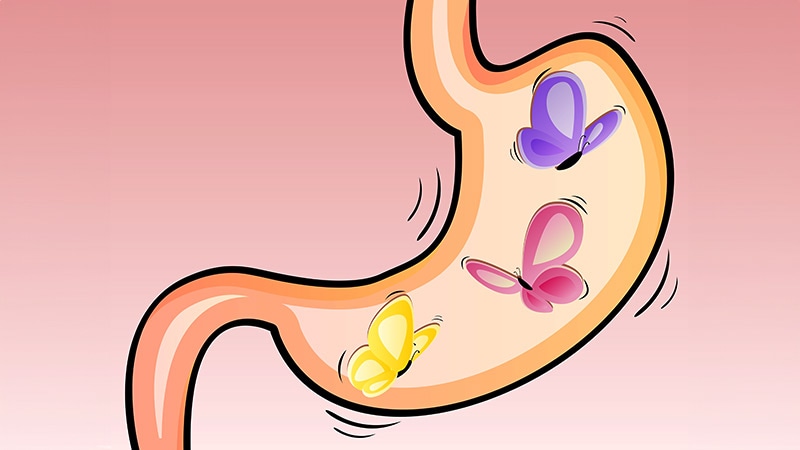Fitness
The Biology of Butterflies in the Stomach

“Having butterflies in the stomach” is not just a figure of speech: Our stomach and our emotions move together. This phenomenon has been measured by Giuseppina Porciello, PhD; Salvatore Maria Aglioti, MD; and collaborators in a study developed by the Department of Psychology at the Sapienza University of Rome, IRCCS-Fondazione Santa Lucia in Rome, and IIT Center for Life Nano- and Neuro-Science in Rome, Italy. The results were published on June 4 in eLife.
The fact that the digestive system and the central nervous system (CNS) are in close and constant communication is well established, hence the talk of a brain-gut axis. Similarly, it is well known that positive and negative emotions, such as disgust or happiness, can evoke subjective sensations in the body, including the stomach. What had been missing was direct and objective evidence that emotions are correlated with changes in gastric physiology.
The Right Question
“The body is not just a representation that enters our brain through the sensory organs. In reality, we are constantly bombarded by signals from within,” said Porciello, the first author of the study. “The body is both the subject and the object of perception. When, for example, we are hungry, we feel hungry because our stomach is letting us know. But do these signals serve only for survival, or do they also contribute to higher-level processes? In all languages, emotions are also manifested through the body. Why do we talk about emotions referring to gastrointestinal signals?”
To answer these questions, Aglioti had the intuition, as Porciello recounted, to use the SmartPill, which is an ingestible capsule commonly used in gastroenterology. SmartPills measure pH, temperature, pressure, and gastrointestinal environment and send the data via Bluetooth to a computer. In addition, the researchers recorded electrogastrography data, ECG, and eyelid beats. Monitored in this way, the 30 subjects of the study watched brief video clips that had been validated in studies to elicit different emotions (eg, disgust, fear, happiness, and sadness) in addition to “neutral” control videos.
The Stomach’s Response
The data showed significant variations in stomach acidity that are correlated with the emotional state. “The more the subjects, especially when they saw disgusting videos, reported feelings of disgust or fear if they saw scary stimuli, the higher the pH. Conversely, a less acidic pH is associated with feelings of greater happiness,” said Porciello. “Even independently of conscious experience, exposure to disgusting videos tended to correlate with a more acidic pH compared with neutral ones. Conversely, videos inducing happiness made the pH less acidic.”
Emotional experience and gastric environment are therefore directly correlated. In other words, the subjective sensation reflects what truly happens in our stomach. However, as Porciello warned, the cause-effect relationship has not yet been rigorously established. “Is it the emotion that causes acidity or acidity that causes the emotion? Studies on animal models are needed, in which conditions are minutely changed, or pharmacologic approaches are needed. For example, we could use a drug that alters stomach acidity and then observe whether disgust is greater or less. What we can say is that gastric signals, specifically stomach pH, seem to have a significant effect on emotional experiences, especially on disgust, happiness, and sadness.”
A Bidirectional Relationship
The study is a first step in understanding the relationships between emotions and the body. It is not just an academic curiosity: Neuropsychologic conditions such as autism are closely related to disorders of the digestive system, and vice versa. Pathologies such as irritable bowel syndrome are associated with a higher incidence of depression.
Studies with a larger and more diverse sample are needed (the participants in this study were all young males), as well as further analyses that address in detail what happens in the digestive system and the brain. The physiologic mechanisms underlying the communication of emotions between the CNS and the stomach remain to be clarified.
The cardiac data from the study showed that, for example, the sensation of disgust is associated with a reduction and greater variability in heart rate, suggesting, in the words of the authors, “sympathetic and parasympathetic activation, resulting in ultimately more intense parasympathetic activity.”
Future studies could clarify the issue, said Porciello. “We are now recording, in addition to gastric activity, brain activity with electroencephalography. We also are analyzing data where, for the first time, we are trying to map the contribution of neural activity.” In other words, how butterflies go from the brain to the stomach, and vice versa.
This story was translated from Univadis Italy using several editorial tools, including AI, as part of the process. Human editors reviewed this content before publication.










